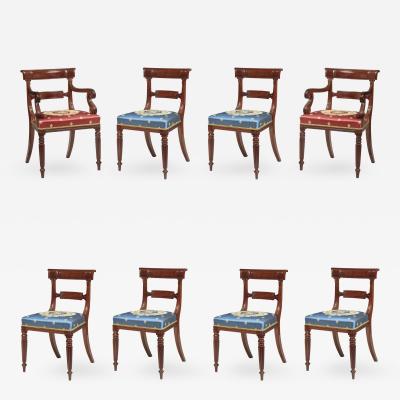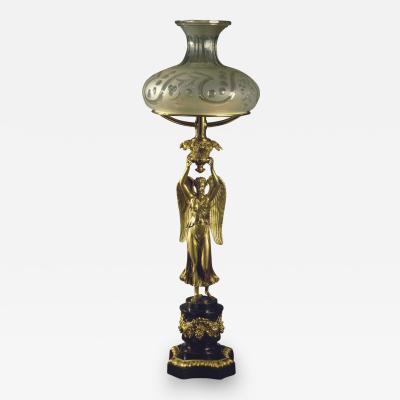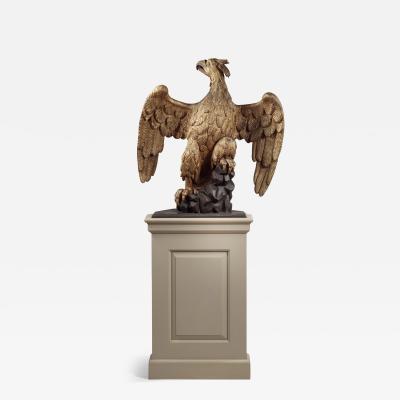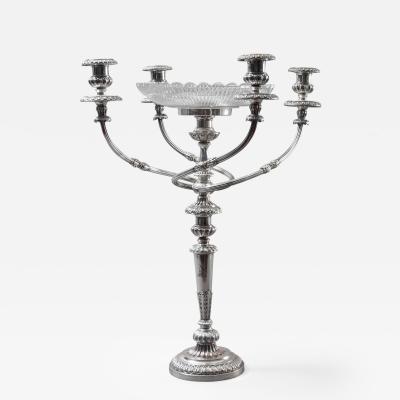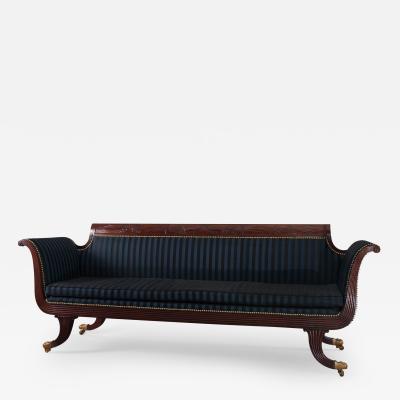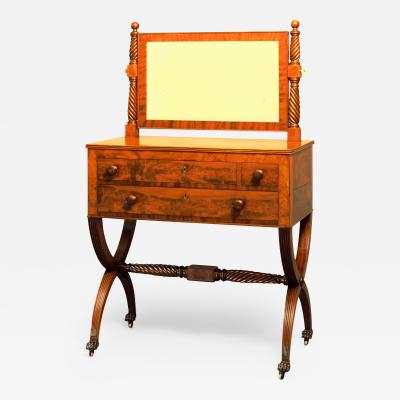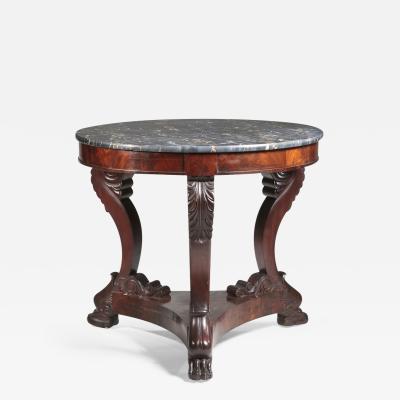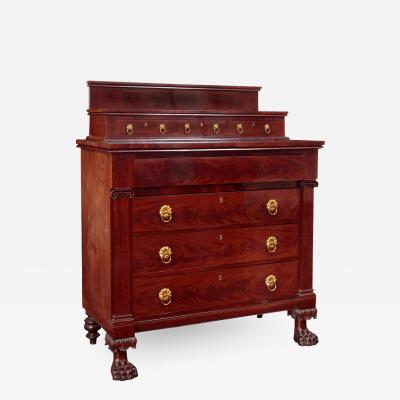Paris Porcelain Partial Dessert Service
-
Description
RUFUS KING FAMILY PARIS PORCELAIN PARTIAL DESSERT SERVICE
“Vintage” Pattern having Borders with Grape and Vine Decoration
on a Salmon-Colored Ground with Gold Highlights
Jean-Pierre Deroche (active 1777-1834), Pochet-Deroche (active 1830-1838)
Marked in black: POCHET / D / Á PARIS
Paris, 1830-1838
Comprising 45 pieces: 10 dinner plates (assiette), 9" (23cm), 4 large plates 11" (28cm), pair of chargers 12" (31cm), pair of square covered dishes, graduating set of 3 oval platters, 12 cups and saucers (gobelet litron), 6 Barrel Covered Custards (pot à crème) (lacking 1 lid), pair of footed compotes H: 8⅞” (22.5cm), round sauce tureen on stand (pot à oglio) (lacking lid), shell-shaped serving dish, (compotier coquille), lobed serving dish, boat-shaped relish dish.
Condition: Excellent: a small rim chip has been restored on one saucer, (a small colored dot has been put on the bottom of the restored piece) A chip to the bottom of the rim of a 9" plate is un-restored. Repair to finial of one pot á crème.
A plate with a closely related pattern with ivy and grape leaves on a pastel ground called “Vintage” made in 1838-55 by Gosse & Vignier Manufactory (active 1838-1860), is at the New Orleans Museum of Art and published in an exhibition catalogue in November 1998.
Gosse was a cousin of Pochet who, in turn, was the son-in-law of either Pierre or Jean-Pierre Deroche, celebrated decorators and Paris porcelain dealers (active 1777-1834). Pochet was brought into the Deroche firm at 16 Rue Jean-Jacques Rousseau 1830-1838 and their product bears the mark of Pochet–Deroche until Gosse joined the firm in
1839-49. By 1834, Pochet–Deroche was considered, along with J.J. Rousseau, the most important Parisian concerns in the porcelain business, according to Régine de Plinval de Guillebon.
Three 9" plates and two of the 11" plates are marked in red cursive, “Boyer, Rue de la Paix, 22.” Boyer was the successor to Feuillet who “was one of the best decorators in the Restauration period.” By 1817 located at 18 Rue de la Paix, Feuillet went into partnership with Boyer about 1834.
A few pieces of this dessert service are in the collection of King Manor Museum in Jamaica, Queens, New York; Rufus King’s home from 1805 to his death in 1827. The manor was inherited by John Alsop King (1788-1867), member of Congress (1848-51) and Governor of the State of New York (1857-58).
Provenance:
This rare and fine dessert service descended to the present day in the family of the Honorable Rufus King (1755-1827), delegate from Massachusetts to the Continental Congress, 1784, member of the Federal Constitutional Convention, 1787, twice member of the U.S. Senate from New York (1789-1796) and (1813-1825), and twice Minister to the Court of St. James (1796-1803) and (1825-1826), and his wife Mary Alsop King (1769-1819).
After being graduated from Harvard in 1777, King embarked on a highly distinguished career in the service of his country. He served as Major and aide-de-camp under General Glover in Rhode Island during the Revolution. Having helped frame the Constitution as a member of the Committee of Style and Arrangement with Alexander Hamilton, he fought successfully to have it ratified by his home State of Massachusetts. He was also an early and vocal opponent of slavery and offered several proposals prohibiting and limiting slavery at the Convention and later in a speech on the Senate floor in February 1820, during debate on the “Missouri Compromise” famously argued, “Mr. President, I have yet to learn that one man can make a slave of another. If one man cannot do so, no number of individuals can have any better right to do it…laws or compacts imposing any such condition upon any human being are absolutely void, because [they are] contrary to the law of nature, which is the law of God…”
Moving to New York in 1789, he entered the U.S. Senate where he was reelected in 1795 but resigned his seat in 1796 to accept the office of Minister to Great Britain at the request of George Washington. He succeeded Thomas Pinckney and was succeeded by James Monroe in the office.
It is not known when this Paris service came into the family but it seems unlikely that it was acquired by Rufus King as Pochet joined the Deroche firm three years after King’s demise. Yet because of his preference for and ownership of Paris porcelain, it is reasonable to assume that, growing up with it, his children could have acquired the same regard for it as their parents. King’s preference for Paris porcelain is well documented in correspondence of October of 1796. He purchased, through his agent, a plateau, three white porcelain groups and two porcelain services from Paris noting that it would have been much more costly to buy in London. His letters also document his purchase of two dinner/desert services from Paris, somewhat less ornamented, evidently, than Mrs. King would have preferred.
The present set is not the one referred to in this 1796 correspondence, yet the letters are clear evidence that King was partial to Paris and evidently viewed acquiring Paris porcelain as a priority as a reflection of his station as a foreign minister, despite the availability of fine English china in London.
King’s will was probated in the County of Queens, New York, May 4, 1827 naming his five sons and their wives as his heirs. King’s taste for French fashion and Paris porcelain, it seems, was inherited by his fourth son, James Gore King (1791-1853), and his wife Sarah Rogers Gracie King (1791-1878). This assumption is consistent with the fact that James also inherited from his father several pieces of high-style classical furniture made by Parisian-trained cabinetmaker Charles-Honoré Lannuier, in the French taste.
James G. King spent the early years of his education in England and France, where he was sent to learn French, while his father was Minister to Britain. He was graduated from Harvard in 1810. He married Archibald Gracie’s daughter in 1813 and returned to England at the end of the War of 1812, to establish, in Liverpool, the banking firm of King & Gracie with his brother-in-law. Returning to New York in 1824, he joined the banking firm of Prime, Ward, Sands and King & Co., a firm that ultimately became James G. King and Sons.
In 1835 he accepted the Presidency of the New York and Erie Railroad. In the ensuing financial Panic of 1837, by his visit to England, he played a central role in the restoration of credit through the agreement he negotiated with the Bank of England and Baring Brothers for a million Pounds Sterling for American bankers. It is very possible that this porcelain service could have been acquired by James King on this visit to England or, indeed, in New York at a fashionable retail emporium and importer such as Baldwin Gardner who is known to have sold Paris porcelain services to prominent New Yorkers.
King moved to “Highwood” a magnificent country estate in Weehawken, New Jersey in 1837 and was elected to congress from New Jersey’s fifth district in 1848 and served until 1851. His portrait by John Trumbull (1756-1843) is in private hands and a miniature on ivory is at the Museum of the City of New York. His portrait by Thomas P. Rossiter (1818-1871) is in the collection of the Chamber of Commerce of the State of New York, of which he was President from 1845 to 1849. A portrait of his wife, Sarah Rogers Gracie King, by Thomas Sully (1783-1872) is in the collection of the Nelson-Atkins Museum of Art in Kansas City, Missouri.
The Paris service descended to their daughter, Fanny Gore King (1836-1905), and her husband James Latimer McLane (1834-1923). McLane, from a prominent Baltimore family, began his career as the assistant District Attorney for the southern district of New York. He returned to Baltimore in 1862 and succeeded to the Presidency of the National Bank of Baltimore. He subsequently was elected President of the North Baltimore Passenger Railroad Company and later the President of the Western Maryland Railroad Company. He served on the Board and became President of the Board of Trustees of Johns Hopkins University and Hospital.
The service then passed to their daughter, Fredrica Gore McLane (1877-1952) and her husband Dr. John Almy Tompkins, Jr. (1871-1965). Dr. Tompkins was the son of J. A. Tompkins (1837-1916) of old Rhode Island stock and a Colonel in the Union Army and Anna Albertine Shriver (1840-1918) who had been married in Frederick, Maryland in 1867. Dr. Tompkins was a distinguished Baltimore surgeon, and later a member of the Navy Department’s Bureau of Medicine and Surgery in Washington.
Their son, John Almy Tompkins III (1905-1977), and his wife Eliza Boyd inherited the service and thence to their daughter from whom it has been acquired. -
More Information
Origin: France Period: 19th Century Materials: Porcelain. Condition: Excellent. Creation Date: c. 1830 Styles / Movements: Classical, Empire Book References: Regine de Plinval de Guillebon, Paris Porcelain, (London, Barrie & Jenkins Ltd., 1972), p. 236. Catalog References: John W. Keefe, Paris Porcelains in the New Orleans Museum of Art, 1998, pl. 22. Incollect Reference #: 117697
Message from Seller:
Carswell Rush Berlin, Inc. – American Classical Furniture
Sold

















